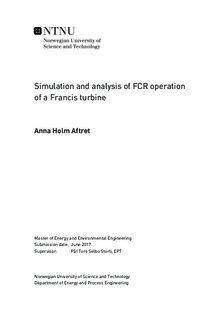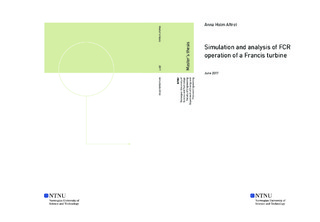| dc.description.abstract | In the Nordic power system, the frequency quality has decreased significantly over the years. One of the reasons for this is a superimposed periodic frequency oscillation with a time period of around 40-90 seconds, which may be due to the increasing amount of unregulated power in the Nordic grid. To increase the frequency quality, a project was initiated to find measures to mitigate the oscillations. From this project, a set of qualification tests for primary governing was specified. Primary governing, also known as frequency containment reserves (FCR), is the first response to a change in frequency of the grid. For a unit to participate in the delivery of FCR, the plant has to pass the requirements set by the project group.
For this reason, Statkraft initiated that a simulation model of Songa hydro power plant should be developed, to perform the qualification tests and assess whether the plant can deliver FCR according to the new requirements. A simulation model was therefore constructed in MATLAB using the Method of Characteristics and equations describing the behaviour of the turbine and governor, as well as a generator connected to the grid.
Frequency containment reserves are divided into two categories, normal and disturbance. The FCR-N delivery is tested by applying a frequency step response and sine sweep. From these tests, the capacity, dynamic performance and stability can be determined from the power response of the unit. Based on the gain and phase of the sinusoidal response, a set of vectors in the complex plane, corresponding to a certain frequency time period, can be developed. These vectors are plotted with circles illustrating the requirements for the dynamic performance and stability. The criteria is fulfilled if the vectors point outside the circle. A final stability verification is performed by a Nyquist diagram obtained by multiplying the FCR-Vectors with a mathematical expression for the grid. The unit has sufficient stability if the Nyquist plot passes the point (-1, $j0$) on the right hand side, and if it bypasses a specified stability margin circle.
The capacity of the FCR-D delivery is determined by a step and ramp response sequence, where the recorded values are the steady-state power response, the active power and energy five seconds after the start of the ramp. To determine the stability, a Nyquist diagram is constructed by the FCR-Vectors and a FCR-D grid transfer function.
Performing the qualification tests on the simulation model of Songa hydro power plant, resulted in a FCR-N capacity of $3.7 MW$ at maximum load and $4.6 MW$ at minimum load, which correspond well to measurements performed at the actual plant. The FCR-N dynamic performance of the unit was shown to be satisfactory, but the stability was more difficult to determine as the stability circles and Nyquist plot came to differing conclusions. An investigation of the grid transfer function, defined by the project group, revealed that the conclusion on stability from the diagram is dependent on how the function is normalized. The FCR-D capacity, and dynamic performance, was negative for all simulations except for FCR-D downwards regulation at minimum load. The Nyquist stability requirement was not achieved for neither of the simulations.
Unfortunately, changing the governor settings did not lead to a more stable system according to the Nyquist stability criteria. | |

